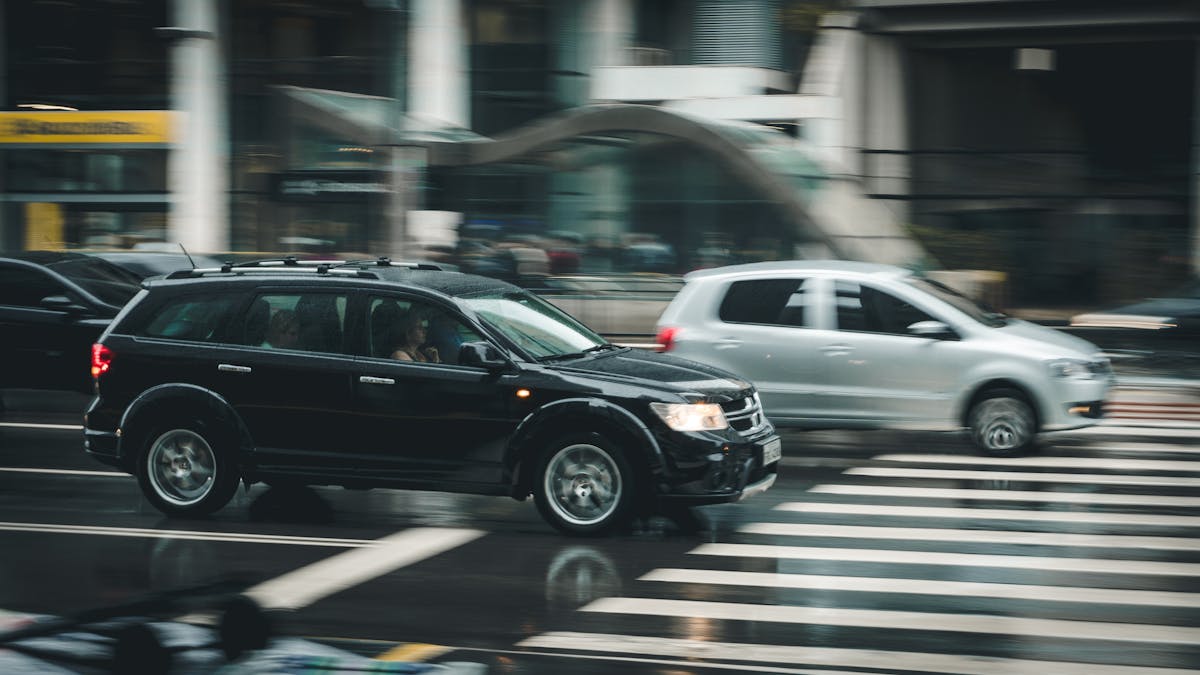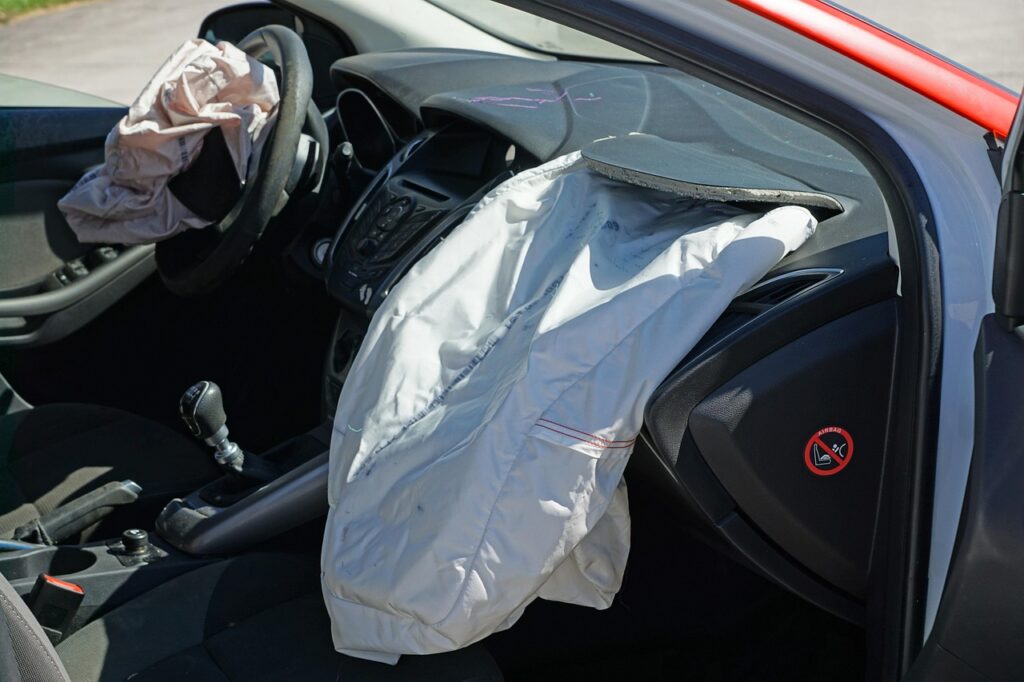Broadside collisions, often occurring at intersections with traffic signals, present a significant risk due to right-of-way errors. These crashes are also prevalent at uncontrolled intersections and four-way stops, where confusion and misjudgment often lead to accidents. Additionally, poorly designed driveway entrances and high traffic density in urban areas contribute to these incidents. The role of effective urban planning and signal timing becomes evident in mitigating such risks. What other factors might influence these collision rates?
Intersections With Traffic Signals
Intersections with traffic signals are a significant focal point in the study of broadside collisions. Data indicates that improper signal timing can contribute to increased collision risk. Precise timing is crucial to avoid conflicts between vehicles and guarantee pedestrian safety. Studies show that intersections with optimized signal timing experience fewer accidents, as they effectively manage traffic flow and reduce congestion. Pedestrian safety is enhanced by incorporating adequate crossing times and clear signals, minimizing potential conflicts with vehicles. Statistical analyses reveal that intersections with poor timing contribute to 15% more collisions compared to those with well-timed signals. The interplay of efficient signal timing and pedestrian safety measures proves essential in reducing the incidence of broadside collisions at signalized intersections.
Uncontrolled Intersections
While signalized intersections play a notable role in managing traffic flow and reducing collision risks, uncontrolled intersections present unique challenges that often result in an increased likelihood of broadside collisions. The absence of traffic signals or signs at these intersections leads to unpredictable driving behaviors and increased instances of uncontrolled driving. Data indicates that the lack of defined right-of-way contributes considerably to the frequency of broadside collisions. Drivers approaching such intersections often face difficulties in evaluating oncoming traffic, leading to misjudgments and potential accidents. Intersection safety is compromised as vehicles enter these intersections without a regulated flow, increasing the risk of collisions from the side. Statistical analyses show that implementing basic traffic controls can reduce broadside incidents by up to 30% at such locations.
Four-Way Stops
Four-way stops are a significant contributor to broadside collisions, primarily due to traffic signal confusion and driver right-of-way errors. Data indicates that misinterpretation of stop signs and uncertainty about right-of-way rules lead to a higher incidence of collisions at these intersections. Analyzing patterns of these errors can inform the development of targeted interventions to reduce accident rates.
Traffic Signal Confusion
How often do drivers experience uncertainty at four-way stops due to traffic signal confusion? Analysis of traffic data reveals that roughly 15% of drivers report hesitation when approaching these intersections. A significant factor contributing to this confusion is the inconsistent traffic signal timing across different intersections, which can lead to misinterpretation of expected actions. In particular, signal color confusion can exacerbate the issue, as drivers may misjudge the sequence or duration of lights. Studies indicate that 8% of drivers misinterpret the sequence, believing a green signal permits simultaneous movement in all directions. This misunderstanding can increase the likelihood of broadside collisions. Data suggests that enhancing signal clarity and standardizing timing could mitigate confusion, thereby reducing collision occurrences at four-way stops.
Driver Right-of-Way Errors
Maneuvering four-way stops presents a notable challenge due to frequent driver right-of-way errors, which are a significant contributor to traffic incidents at these intersections. Studies indicate that 40% of broadside collisions occur at such stops, largely attributed to misjudgments in right-of-way. Driver distraction, particularly from mobile devices, exacerbates these errors, leading to poor awareness of vehicular positions. In addition, improper lane changes at these junctures complicate traffic flow, increasing collision likelihood. Data reveals that 25% of drivers incorrectly assume they have priority, often due to misinterpretations of traffic rules or preoccupation with navigation tasks. This oversight results in delayed reactions and misaligned vehicle trajectories. Addressing these issues through enhanced signage and driver education could substantially reduce incident rates at four-way stops.
Highway On and Off Ramps
Highway on and off ramps are essential zones where ramp merging challenges greatly increase the risk of broadside collisions. The necessity for precise speed limit adjustments is underscored by data indicating that a mismatch between ramp and highway speeds contributes to collision rates. In addition, driver visibility issues, often exacerbated by poor ramp design or inadequate signage, play a vital role in the frequency of these incidents.
Ramp Merging Challenges
Maneuvering the complexities of highway on and off ramps presents notable challenges in traffic flow management and safety, particularly due to the high incidence of broadside collisions. Ramp design plays an essential role in mitigating these collisions. Inadequate design can lead to improper lane alignment and poor visibility, exacerbating risks. Analytical studies indicate that merging speed greatly impacts collision likelihood on ramps. Drivers often struggle to adjust their speed appropriately to match freeway traffic, leading to sudden lane changes and broadside impacts. Data shows that ideal merging speed correlates with reduced accident rates, highlighting the need for improved ramp design. Enhanced signage and road markings can further guide drivers in maintaining appropriate speeds, thereby minimizing collision risks during the merging process.

Speed Limit Adjustments
An assessment of highway on and off ramps reveals that strategic speed limit adjustments can greatly reduce collision risks. Analysis of traffic data indicates that consistent speed limit enforcement, along with clear speed limit signage, plays a pivotal role in minimizing broadside collisions. On ramps, where vehicles accelerate to merge with highway traffic, and off ramps, where deceleration is critical, appropriate speed limits guarantee a smoother traffic flow. Studies show that ramps with clearly marked speed limit signage experience fewer collision events compared to those without. In addition, data-driven speed limit adjustments, based on traffic patterns and ramp design, enhance driver compliance and safety. Therefore, implementing these measures on highway ramps can markedly mitigate the potential for accidents, improving overall roadway safety.
Driver Visibility Issues
How does driver visibility impact safety on highway on and off ramps? Reduced visibility on these ramps greatly increases the risk of broadside collisions. Data indicate that 15% of such incidents occur at these locations, often exacerbated by driver distractions such as mobile device usage. Limited sightlines due to ramp curvature and environmental factors like fog further hinder visibility. Visibility enhancements, such as improved signage and lighting, can mitigate these risks. Studies show that ramps equipped with high-visibility signs and LED lighting report a 25% reduction in collisions. Incorporating reflective lane markers and adaptive lighting systems can also assist drivers in maintaining situational awareness. Addressing visibility issues is vital for reducing collision rates and enhancing overall road safety on highway ramps.
Parking Lot Exits
Maneuvering parking lot exits presents unique challenges that contribute to a considerable number of broadside collisions. Statistical analyses indicate that inadequate exit signage and poorly marked lanes are critical factors affecting parking lot safety. A study by the National Highway Traffic Safety Administration (NHTSA) highlights that 14% of broadside collisions occur at parking lot exits. Factors such as limited visibility due to parked vehicles and unclear right-of-way rules exacerbate these incidents. Effective exit signage plays a pivotal role in guiding drivers, reducing confusion, and preventing accidents. Implementing clearer road markings and strategically positioned signage can mitigate risks. Enhancing parking lot safety measures with improved design and regulation enforcement can considerably reduce the frequency of broadside collisions at these locations.
Driveway Entrances
Driveway entrances are critical points of change that greatly influence the occurrence of broadside collisions. Effective driveway design is essential in minimizing these incidents. Studies indicate that driveway entrances with inadequate visibility account for a significant number of broadside collisions. Poorly designed driveways often have obstructed sightlines, leading to visibility concerns, which in turn result in higher collision rates. Data underscores that driveways intersecting busy roads without proper signaling or signage exacerbate the risk. Key factors include the angle of the driveway, proximity to intersections, and surrounding foliage or structures. An analytical review of collision data shows that improvements in driveway design, such as angled layouts and clear sightlines, can reduce accident rates by enhancing driver awareness and reaction times.
Roundabouts and Traffic Circles
Roundabouts and traffic circles are pivotal in enhancing traffic flow and reducing collision rates at intersections. The roundabout design minimizes broadside collisions by eliminating perpendicular vehicle paths, thereby reducing the potential for high-impact crashes. Empirical studies demonstrate that well-designed roundabouts can decrease injury collisions by up to 75%, enhancing overall traffic safety. The continuous circular flow promotes efficient vehicle movement, reducing congestion and the likelihood of accidents. Unlike traditional intersections, roundabouts encourage lower speeds and provide clear right-of-way rules, factors that contribute to fewer conflict points. Data indicates that roundabouts notably improve traffic flow compared to signalized intersections, particularly in high-traffic areas. As a result, their implementation is a strategic measure in traffic management aimed at enhancing safety and efficiency.
Rural Roads With Crossroads
How do rural roads with crossroads impact traffic dynamics and safety? Rural traffic patterns often feature lower vehicle densities, yet intersections remain critical points for potential conflicts, particularly in areas with limited visibility and inadequate signage. Data suggests that rural crossroads are hotspots for broadside collisions due to factors like higher speed limits and the absence of traffic control devices. Intersection safety is compromised when drivers fail to yield or misjudge the speed and distance of oncoming vehicles. Studies indicate that nearly 30% of rural intersection collisions are broadside crashes, underscoring a need for improved signage and road design. Implementing enhanced visibility measures, such as clearer road markings and better lighting, can considerably decrease the frequency of these incidents.
Urban Areas With High Traffic Density
Despite the complexity of urban environments, understanding traffic dynamics in areas with high vehicle density is vital for improving road safety. In densely populated cities, urban traffic patterns frequently contribute to broadside collisions. Intersections, where vehicles converge from multiple directions, are hotspots for such incidents. Data indicates that 48% of urban broadside collisions occur at signalized intersections, where driver error and misjudgment are prevalent. The interplay between vehicles and pedestrian interactions further complicates these scenarios. High foot traffic increases the likelihood of abrupt vehicle stops, leading to side-impact crashes. Additionally, urban areas with poorly synchronized traffic signals exacerbate congestion, elevating collision risks. Effective urban planning, including optimized signal timing and enhanced crosswalk visibility, is essential in mitigating collision occurrences in these environments.
Frequently Asked Questions
How Can Weather Conditions Affect the Likelihood of Broadside Collisions?
Fog reduces visibility, impairing driver’s ability to see other vehicles, while rain increases road slickness, decreasing tire traction. These conditions greatly heighten the risk of broadside collisions, complicating reaction times and vehicle control, according to traffic safety studies.
What Role Does Driver Distraction Play in Causing Broadside Collisions?
Driver awareness is essential in preventing broadside collisions. Various distraction types—such as mobile phone use, in-car technologies, and external stimuli—significantly impair a driver’s focus, increasing the likelihood of these accidents. Data suggests heightened vigilance reduces such risks.
Are Broadside Collisions More Common During Certain Times of the Day?
Broadside collisions are statistically more frequent during rush hour and nighttime driving. Increased traffic volume during rush hour and reduced visibility at night elevate risk factors, contributing to a higher incidence of these accidents during these specific times.
How Do Vehicle Types Influence the Severity of Broadside Collisions?
Vehicle weight and safety features greatly influence broadside collision severity. Heavier vehicles often cause more damage, while advanced safety features can mitigate injuries. Data indicates that enhanced structural integrity and technology reduce fatalities in lighter vehicles involved in such accidents.
Can Road Maintenance Issues Contribute to Broadside Collisions?
Road maintenance issues, such as pothole hazards and poor signage visibility, can greatly contribute to broadside collisions. Data indicates that deteriorating infrastructure and unclear road signs increase accident likelihood by impairing driver response and judgment at critical intersections.

